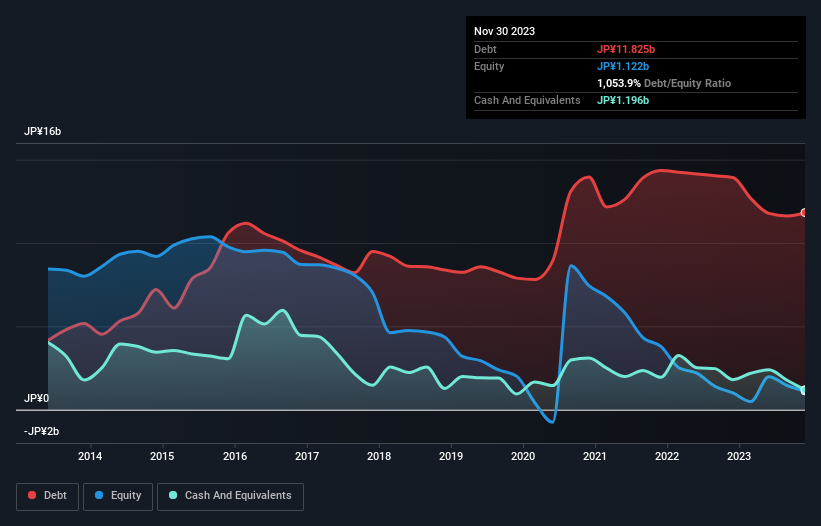
Legendary fund manager Li Lu (who Charlie Munger backed) once said, 'The biggest investment risk is not the volatility of prices, but whether you will suffer a permanent loss of capital.' So it might be obvious that you need to consider debt, when you think about how risky any given stock is, because too much debt can sink a company. As with many other companies Samantha Thavasa Japan Limited (TSE:7829) makes use of debt. But is this debt a concern to shareholders?
Why Does Debt Bring Risk?
Debt is a tool to help businesses grow, but if a business is incapable of paying off its lenders, then it exists at their mercy. Part and parcel of capitalism is the process of 'creative destruction' where failed businesses are mercilessly liquidated by their bankers. While that is not too common, we often do see indebted companies permanently diluting shareholders because lenders force them to raise capital at a distressed price. Of course, plenty of companies use debt to fund growth, without any negative consequences. When we examine debt levels, we first consider both cash and debt levels, together.
Check out our latest analysis for Samantha Thavasa Japan
What Is Samantha Thavasa Japan's Debt?
You can click the graphic below for the historical numbers, but it shows that Samantha Thavasa Japan had JP¥11.8b of debt in November 2023, down from JP¥13.9b, one year before. However, because it has a cash reserve of JP¥1.20b, its net debt is less, at about JP¥10.6b.

How Strong Is Samantha Thavasa Japan's Balance Sheet?
The latest balance sheet data shows that Samantha Thavasa Japan had liabilities of JP¥13.1b due within a year, and liabilities of JP¥1.59b falling due after that. Offsetting this, it had JP¥1.20b in cash and JP¥1.41b in receivables that were due within 12 months. So it has liabilities totalling JP¥12.1b more than its cash and near-term receivables, combined.
This deficit casts a shadow over the JP¥6.72b company, like a colossus towering over mere mortals. So we definitely think shareholders need to watch this one closely. After all, Samantha Thavasa Japan would likely require a major re-capitalisation if it had to pay its creditors today. The balance sheet is clearly the area to focus on when you are analysing debt. But it is Samantha Thavasa Japan's earnings that will influence how the balance sheet holds up in the future. So if you're keen to discover more about its earnings, it might be worth checking out this graph of its long term earnings trend.
In the last year Samantha Thavasa Japan had a loss before interest and tax, and actually shrunk its revenue by 8.4%, to JP¥24b. We would much prefer see growth.
Caveat Emptor
Over the last twelve months Samantha Thavasa Japan produced an earnings before interest and tax (EBIT) loss. Indeed, it lost a very considerable JP¥1.2b at the EBIT level. Considering that alongside the liabilities mentioned above make us nervous about the company. We'd want to see some strong near-term improvements before getting too interested in the stock. Not least because it had negative free cash flow of JP¥1.2b over the last twelve months. So suffice it to say we consider the stock to be risky. There's no doubt that we learn most about debt from the balance sheet. But ultimately, every company can contain risks that exist outside of the balance sheet. These risks can be hard to spot. Every company has them, and we've spotted 3 warning signs for Samantha Thavasa Japan (of which 2 are significant!) you should know about.
When all is said and done, sometimes its easier to focus on companies that don't even need debt. Readers can access a list of growth stocks with zero net debt 100% free, right now.
If you're looking to trade Samantha Thavasa Japan, open an account with the lowest-cost platform trusted by professionals, Interactive Brokers.
With clients in over 200 countries and territories, and access to 160 markets, IBKR lets you trade stocks, options, futures, forex, bonds and funds from a single integrated account.
Enjoy no hidden fees, no account minimums, and FX conversion rates as low as 0.03%, far better than what most brokers offer.
Sponsored ContentNew: Manage All Your Stock Portfolios in One Place
We've created the ultimate portfolio companion for stock investors, and it's free.
• Connect an unlimited number of Portfolios and see your total in one currency
• Be alerted to new Warning Signs or Risks via email or mobile
• Track the Fair Value of your stocks
Have feedback on this article? Concerned about the content? Get in touch with us directly. Alternatively, email editorial-team (at) simplywallst.com.
This article by Simply Wall St is general in nature. We provide commentary based on historical data and analyst forecasts only using an unbiased methodology and our articles are not intended to be financial advice. It does not constitute a recommendation to buy or sell any stock, and does not take account of your objectives, or your financial situation. We aim to bring you long-term focused analysis driven by fundamental data. Note that our analysis may not factor in the latest price-sensitive company announcements or qualitative material. Simply Wall St has no position in any stocks mentioned.
About TSE:7829
Samantha Thavasa Japan
Plans, manufactures, and sells handbags and jewelry in Japan and internationally.
Mediocre balance sheet and slightly overvalued.
Market Insights
Community Narratives




